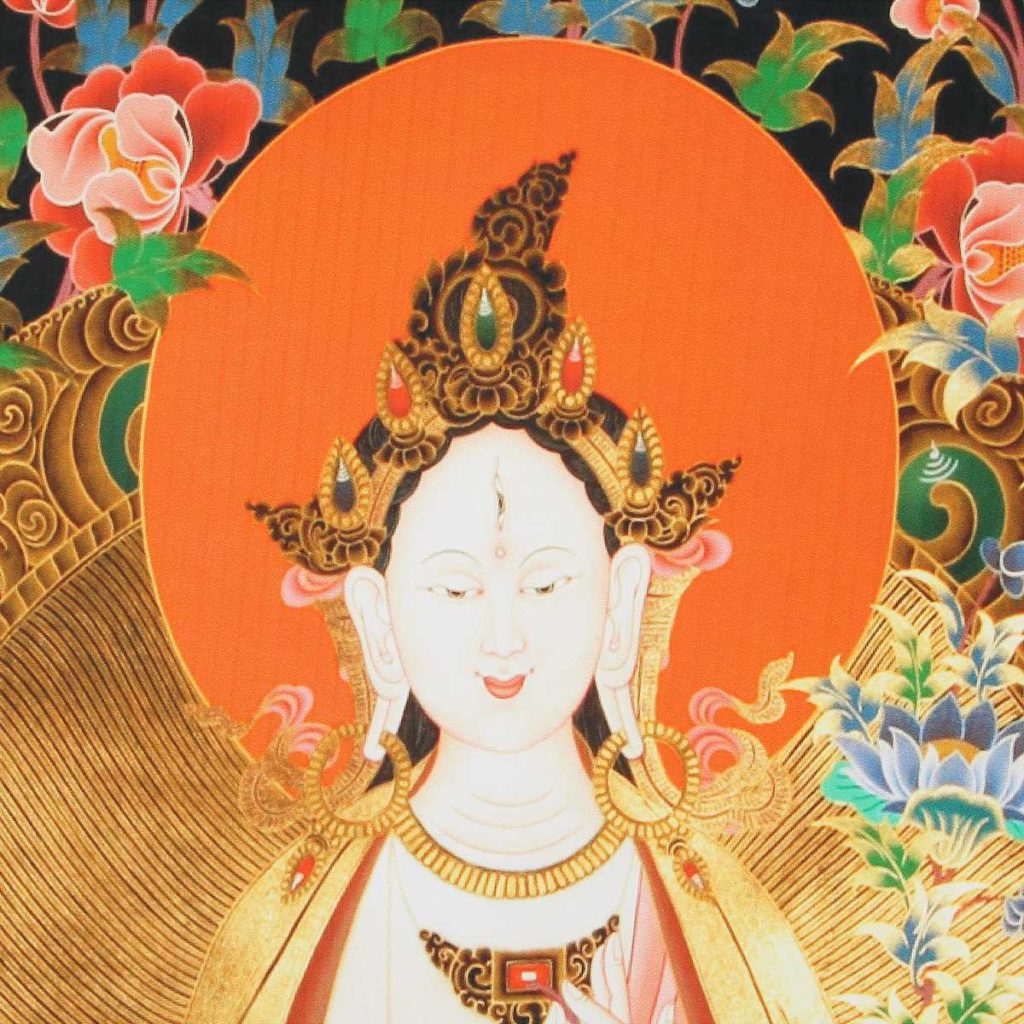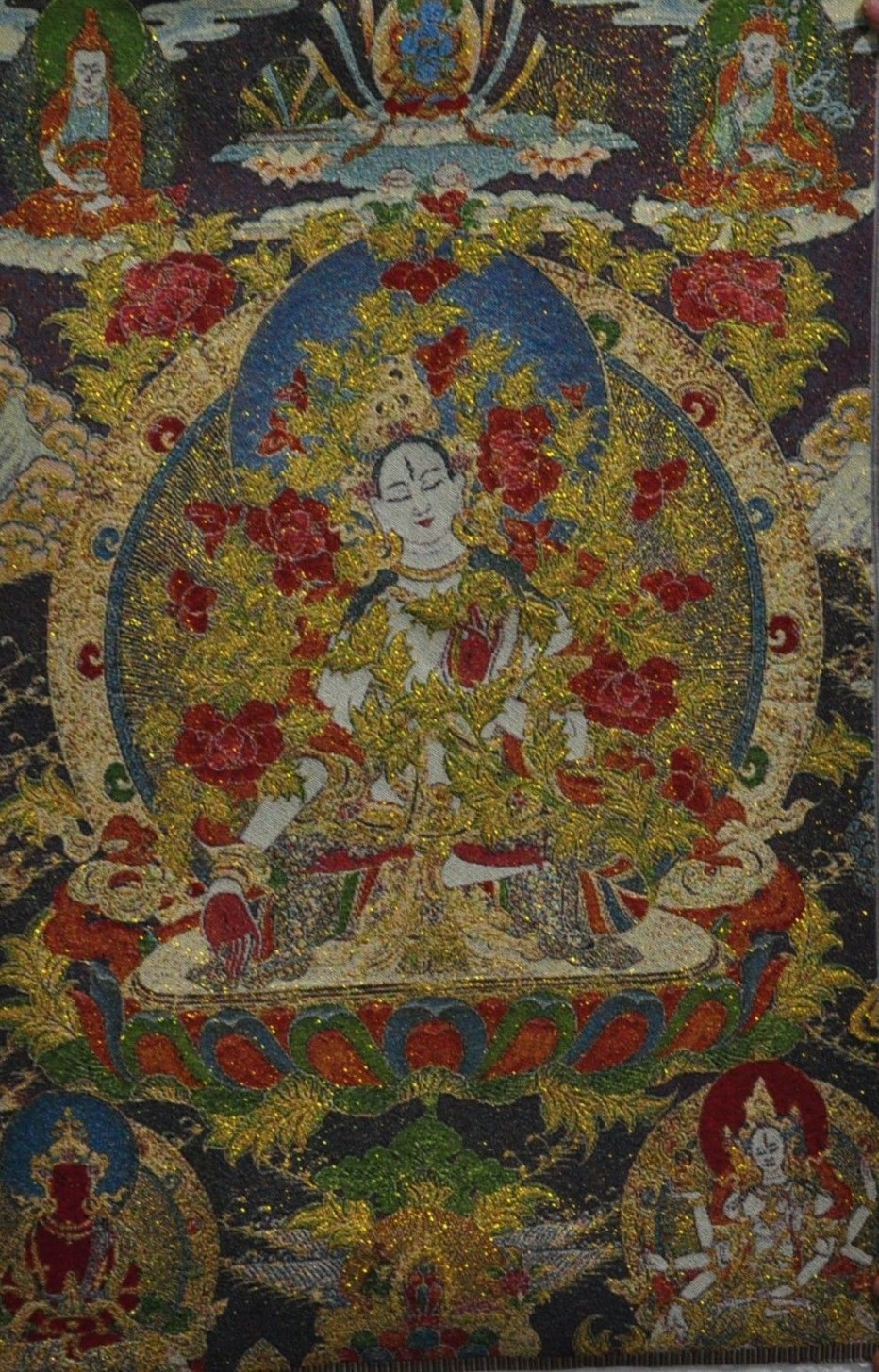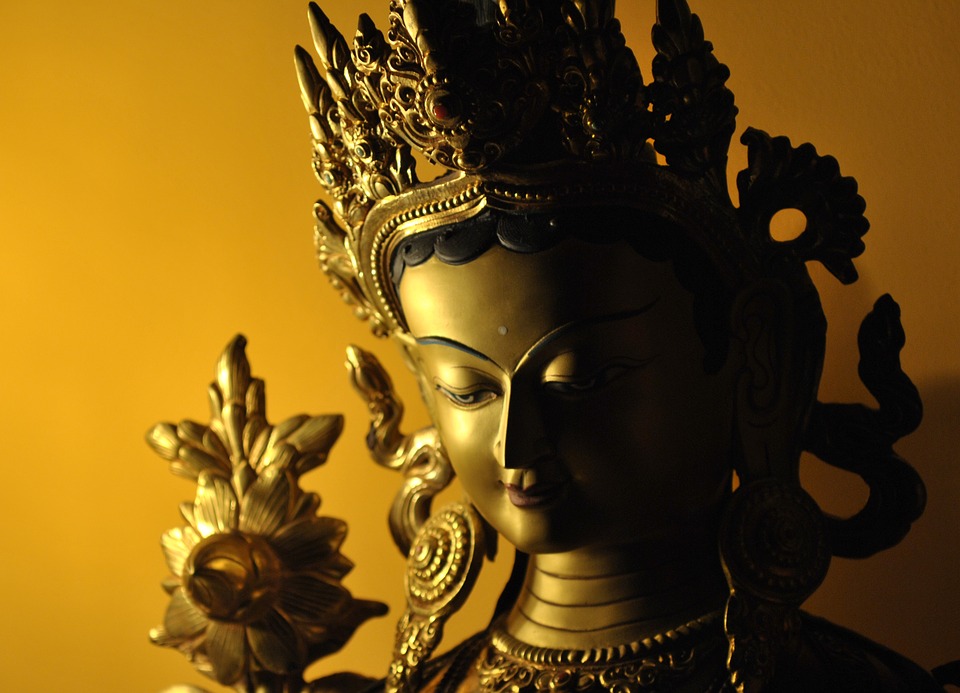Buddhism corresponds to a philosophical and religious current that is widely followed by many people in the world, characterized by different currents that are applied that have various deities to worship, let us know here in this article about The Protective Buddhist Goddess.

The Protective Buddhist Goddess
Buddhism corresponds to a philosophical and also spiritual doctrine, for many it is considered as the correct path of the teaching that was applied by Buddha. For many it is considered a religion but also a philosophical current that has a set of ideas to achieve the mental liberation of people. They are responsible for applying meditation, liberation and prayer in order to find spiritual enlightenment, they are not based on following a specific God or deity.
Buddhism is a belief of Hindu origin that began with the pilgrimage methods carried out by Buddha, imparting the various wisdom teachings throughout India. Over time, Buddhism became one of the most followed religions in India and currently has a great boom worldwide, applying three types of currents known as Terevada (oldest currents and ancient beliefs), Mahyana (applies the teachings as a method verification) and Vajrayana (Most current trend with application of deities and mantras).
Among some of the divinities that stand out in Buddhism as a protective goddess, Tara stands out, a protective Buddhist goddess, which corresponds to a female deity from the Vajrayana current, being completely related to Tantric Buddhism. Tara means savior and protector, she is also considered the mother of liberation, she represents great characteristics to be applied in the success of work and various feats. Tara represents a generic name for a group of Buddhas that have similar appearance, widely followed by Tibetan Buddhism.
Principal Forms of Buddhism
Buddhism has been characterized as a very iconographic religious and philosophical current, where it has a large number of temples and monasteries with statues and walls complete with various paintings, highlighting among them various forms of Buddha with respect to beliefs and trends. Among them are reflected the figures of the protective Buddhist goddess, Tara, with a great variety of forms that are very followed, revered and known, let us know some:
- Śyāmatārā (Dark Savior): She is also known as Green Tara, presenting herself as an enlightened activity and one that can support overcoming different obstacles, being one of the most followed and revered images.
- Sitatārā (White Savior), also known as the White Tara, is highly revered along with the Green Tara, represents compassion, serenity and healing, also highly sought after for carrying the wish-fulfilling wheel (Chinta-Chakra)
- Kurukulla: also presents the name of Red Tara, which is attributed for presenting a violent aspect, being completely associated with the power of attraction of money and the couple.
- Black Tara: It is considered as the angry one, completely related to power.
- Yellow Tara: considered to be the tare of wealth and also of prosperity.
- Blue Tara: also known as Ekajati, fully associated with the transmutation of anger.
- Chintámani Tara: it can be confused, very applied in Tantra Yoga, it is very applied in Tibetan Buddhism, it can be confused with the Green Tara.
- Khadiravani Tara: Known as the Tara of the Acacia Forest, who made an appearance in South India.
The Tibetan schools are in charge of reflecting that there are 21 representative figures of Tara, they are classified into different types of activities, mainly 4 types are reflected that are represented by their colors: The first as the Peacemakers (White Tara), the second as the increaser (Yellow Tara), the third as the winner (Red Tara) and the fourth as the angry one (Black Tara). They are considered the main classifications that Tara figures have.
Emergence as a Buddhist Deity
Buddha represents a Sanskrit word that means "The one who woke up", corresponds to a man who renounced the pleasures of life to dedicate himself to meditation and help the poor, over time he reached the highest degree of wisdom known as Nirvana and with This began a process of pilgrimage through India to explain the current of Buddhism, after Buddhism died, it became a religion throughout India, building statues and monuments in its name, among some of its figures Tara is represented.
In Tibetan Buddhism Tara is a female representation of the Buddha but is also part of the symbology of Buddhism. There are several outstanding stories regarding Tara, among them stands out, that he was born from a tear of Chenrezing (Buddha of compassion), This Buddha is in charge of guiding all human beings out of samsara but on one occasion he felt his strength weaken due to the difficulty of guiding each of the people, however he had a great compassion that he began to cry for them.
At the moment he began to cry, he felt great pain and compassion for the people, those tears when they reached the ground, the white and green Taras appeared, who were in charge of giving him support and filled him with strength to comply with the role he had. For this reason, in Tibetan belief Tara is taken every morning as the mother of Buddha who is in charge of guiding all enlightened beings.
Tara is considered as a savior, where she is reflected as a divinity that is in charge of listening to all the laments that human beings have or people who experience pain or misery in Samsara (cycle of life that represents birth, life and death). In the middle of the XNUMXth century, she was adopted by the Pala empire into a Buddhist pantheon, recognizing her as a Bodhisattva (way of the Buddha), receiving the name of mother goddess along with four other representations.
During the appearance of the Prajñāpāramitā-sūtra they correspond to a set of writings that were adopted by the Mahayana Buddhist current, where the feminine principle is indicated and where the first appearance of Tara is visualized as the mother of perfect wisdom and later they present her as the perfect compassion, also reflecting as the mother of all buddhas, being a term widely applied by practitioners where they respect the margins of the deity, not imposing another deity.
The different expressions of this protective Buddhist goddess are completely related to maternal qualities directly related to compassion and mercy. Over time Tara became a very close deity for people because of the ease of her worship without the intervention of monks, especially for the common people of India, becoming very popular and highly venerated in the mid-XNUMXth century. She remains very vehemently in Tibet and Mogolia, being a very familiar image among her practitioners.
Tara as Savior
The image of Tara is considered one of the Buddhist expressions with the greatest feminine relationship, being considered one of the feminine inspirations of the universe and for her image of Mother of Mercy. The practice to this deity is followed by representing the birth of cordiality and also related to the relief of bad karma that can come to torment different people. Therefore, the extreme quality and characteristics of it are representative and very popular.
Standing out in this case is Green Tara, who is in charge of offering help and various protections for all kinds of circumstances that can become unfortunate in people's Samsara. In the case of Tara la Blanca, she is characterized by reflecting maternal love and various feelings of compassion at all times, therefore, she is in charge of offering healing to the different beings that are injured, both physically and psychologically.
In the case of the Red Tara, also known as Kurukula, it is the tare related to consciousness and that is responsible for discriminating the various created phenomena and also transforming a raw desire into true love and compassion. There is also the Blue Tara known as Ekayati, characteristic for presenting a very volatile and fierce energy, being widely used to destroy obstacles, also standing out as the protector of the Nyingma lineage, corresponding to the first instructors of Buddhism in Tibet.
Tara as Tantric Divinity
The characteristics of Tara as a savior encompass a large set of varieties, mainly pointing out her love for humanity and for being a dedicated woman, there are various stories that encompass her unique qualities, there are various legends that encompass Tara, among them one stands out where it is reflected as a person who existed eons ago.
Thousands of years ago, considering in a universe very far from the current one, there was a princess who was known as Yeshe Dawa, she was a high society woman surrounded by luxuries and full of privileges of palace life, despite this she did not let herself be wrapped by the material but developed a great faith and love for the people around her, with this she developed a great faith related to the three jewels developing the study of the dharma.
The princess continued to study and reflect on the dharma, awakening a great aspiration and desire to free all those people, including millions of human beings, from suffering. Her desire was very deep to the point of committing herself to liberate the millions of beings before being able to eat any food before breakfast and in the same way to liberate millions more before consuming any food for lunch and also millions more before dinner. .
This attitude was known everywhere, due to her nobility and position to help many, therefore, she began to be known as Arya, being representative of Noble and over time she became known as Tara the liberator. Despite this, he did not receive much support from the different religious authorities that were in charge of supporting the palace, recommending to the young princess that she not try so hard, it was better to offer those reflections on being reborn as a male figure that would influence the society.
The princess listened to such advice, rejected it completely and promised to always be reborn in her only female form, from that moment she returned to the world again and again always reflecting that maternal love, always thinking of the benefit of human beings and mainly for be an example among all those women who reflect the same passion for the same path of practicing dharma.
There is a wide variety of stories that encompass Tara, leading to various interpretations that represent her as a tantric divinity, which represents physical practice, known as the fast track and is considered the point where Buddha achieved the greatest enlightenment, for this reason it is considered as a yoga divinity mainly for the version of Kurukula (Red Tara).
There are various classified stories in this case it was considered as a divinity due to Padmasambhava to Yeshe Tsogyal (Queen of the Lake and Wisdom), the man asked the queen of the lake and the wisdom that will hide a great treasure from him, with the Over time the treasure was rediscovered, over time the holiness of the moment reincarnated in Sakya Trizin and it was possible to relay that message to the holiness of the moment, spreading them to the various Western disciples.
Spiritual Practices
In Buddhism, sadhanas are well known, corresponds as a means to achieve something specific, well known as a yogic practice, where it refers to the various instructions that are used to perform a specific practice. The main objective is to achieve a spiritual realization together with enlightenment, among some of its most common practices are meditation and also the chanting of mantras dedicated to a specific deity.
In this case it should also be noted that in Vajrayana Buddhism it uses the ending of Yidam, being characteristic as a being that is enlightened, being the main focus of meditation that can be used for the practitioner, in a few words it corresponds to the deity in who is meditating. In the case of practitioners and followers, they are responsible for using Tara as a yidam in their various sadhana practices, whether they are very long or short.
Normally a set of prayers are used to be able to invoke or make present the presence of the deity, then it is essential to perform a chant as its mantra, then it must be respectively visualizing the deity, in this case Tara, with the color and shape respective that you want to invoke, because each form of Tara has an outstanding characteristic and function.
Then proceed to say merits and dedicate them exclusively to the deity chosen by each of the people who feel the need for aspirations, some of the sadhanas of the deity Tara can be considered as opening or initial practices for what is Vajrayana Buddhist belief, this only happens when you have a good visualization of the deity in order to have the sublime teachings completely related to Buddhism.
Importance
It is very important that during the moment of creation of this protective Buddhist goddess as the Yidam of the practice, during the beginning stage it must be visualized as a reality but also as any other perception of the mind being made for mantra recitation and visualizing it as a image of compassion and wisdom. After a time of practices, some of the qualities that her being is responsible for representing should be shared.
Once this type of connection is developed, it allows them to become inseparable from the yidam and each time the sadhanas is performed, it is much more intense and extensive, trying to openly reflect, emanating various qualities similar to the rainbow, having it as a visualization as long as the Tara deity and renouncing the ordinary "I".
In the end the intention is to be able to merge with the deity and dissolve into the created form, which can be considered as a "me" but created based on the mind and may lack any long-term existence, it will only be present as long as it has been created. completed the training and practice of meditation. Through this stage of meditation, the practitioner is able to approach various stages, allowing a connection with the void but also with the light.
Through this type of practice it has various purposes, whether it is spiritual to establish some contact with the deity, but it is also used to unblock the chakra knots or also known the different psychic centers, all this in order to allow energy to flow throughout. the body correctly and without interruption, all this is necessary to be able to progress in a deeper and more advanced way.
https://www.youtube.com/watch?v=lPjvxWi4ewE
It is highlighted that the sadhana of Tara can become completely invisible events that are carried out through internal but also external events, there are various studies focused on reflecting the phenomenon that takes place, among them the Divine Yoga written by Dalai stands out. Lama, which are responsible for reflecting the various tantric practices using various yidam.
There are several results when using Tara as a yidam, among them we can highlight the reduction of the forces of any negative karma in the person's life, which can influence diseases, generate different pains and bring obstacles to their life, all this submerges in a state of darkness, through this type of experience various external circumstances that can harm the day to day of any person are improved.
In addition, it can also influence in improving the mental conditions of the practitioners and in turn collaborating in being able to purify the different psychic channels, allowing generosity to calm the spirit and cleanse the mind, thus causing compassion to flow from the center of the heart. Allowing at all times the emotions of compassion, generosity and love to flow from the heart and allowing all channels to be opened.
Prayers to Tara
The image of Tara is considered one of the Buddhist expressions with the greatest feminine relationship, being considered one of the feminine inspirations of the universe and for her image of Mother of Mercy. The practice to this deity is followed by representing the birth of cordiality and also related to the relief of bad karma that can come to torment different people. Therefore, the extreme quality and characteristics of it are representative and very popular.
There are a large number of prayers and prayers raised towards Tara are recited through moments of meditation, some of the most popular is the one highlighted below:
Honorable Tara, I beseech you, both you and your entourage,
that you remember with love your promise of the past
and release my fears and those of all beings.
Dispels the dark mentality in the face of adversity.
May harmonious circumstances flourish
and grant us the ordinary and supreme siddhis ['mental powers'].
om tare tu tare ture soja.
Tara Kuan Yin
Buddha is the main image followed by Buddhism, there is a large set of presentations that are allusive to various versions and presentations followed by Buddhist currents, among them we can highlight Tara Kwan Yin, which corresponds to one of the versions of female Buddha that they are highly recognized and also followed for their great compassion.
It has a large number of followers who represent that the Tara Kwan Yin reached a moment of enlightenment and decided that they could not accept it because they wanted to stay with people and thus be able to help them completely heal their souls, due to all this. Reiki is born from a special lineage known as Kun-Li, this lineage is highly recognized for its various applications where they have Tara Kwan Yin as their center and she is the main representative image of all their dogmas.
Various mantras or special rituals are used to achieve a correct invocation of Tara Kwan Yin known as om tare tuttare ture swahaThrough this type of mantra, the invocation of the 21 images or tares known in Tibet and in the world is performed.
We hope that this article has been helpful, we leave you the following links to other articles that will surely interest you:




